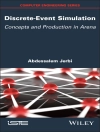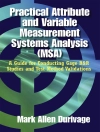The proceedings of Soc Pro S 2015 will serve as an academic bonanza for scientists and researchers working in the field of Soft Computing. This book contains theoretical as well as practical aspects using fuzzy logic, neural networks, evolutionary algorithms, swarm intelligence algorithms, etc., with many applications under the umbrella of ‘Soft Computing’. The book will be beneficial for young as well as experienced researchers dealing across complex and intricate real world problems for which finding a solution by traditional methods is a difficult task.
The different application areas covered in the proceedings are: Image Processing, Cryptanalysis, Industrial Optimization, Supply Chain Management, Newly Proposed Nature Inspired Algorithms, Signal Processing, Problems related to Medical and Health Care, Networking Optimization Problems, etc.
สารบัญ
Chapter 1. Optimization of Non Local Means Filtering Technique for Denoising Magnetic Resonance Images: A Review.- Chapter 2. A Production Model with Stock Dependent Demand, Partial Backlogging, Weibull Distribution Deterioration and Customer Returns.- Chapter 3. Chemo-inspired Genetic Algorithm and Application to Model Order Reduction Problem.- Chapter 4. Grammatical Evolution Using Fireworks Algorithm.- Chapter 5. Gaussian Function Based Particle Swarm Optimization.- Chapter 6. Reinforcing Particle System Effects Using Object Oriented Approach and Real Time Fluid Dynamics for Next Generation 3D Gaming.- Chapter 7. Searchless Fractal Image Compression Using Fast DCT and Real DCT.- Chapter 8. Study of Neighborhood Search Based Fractal Image Encoding.- Chapter 9. An Optimized Color Image Watermarking Technique Using Differential Evolution and SVD-DWT Domain.- Chapter 10. One Day Ahead Forecast of Pan Evaporation at Pali Using Genetic Programming.- Chapter 11. Optimized Scenario of Temperature Forecasting Using SOA and Soft Computing Techniques.- Chapter 12. Software Reliability Prediction Using Machine Learning Techniques.- Chapter 13. A Genetic Algorithm Based Scheduling Algorithm for Grid Computing Environments.- Chapter 14. Effect of Imperfect Debugging on Prediction of Remaining Faults in Software.- Chapter 15. Multiple Document Summarization Using Text Based Keyword Extraction.- Chapter 16. Implementation of the Principle of Jamming for Hulk Gripper Remotely Controlled by Raspberry Pi.- Chapter 17. Differential Evolution: An Overview.- Chapter 18. Multi-objective Parametric Query Optimization for Distributed Database Systems.- Chapter 19. Energy Efficient Routing Protocol for MANET Using Vague Set.- Chapter 20. Data Storage Security in Cloud Paradigm.- Chapter 21. Axisymmetric Vibrations of Variable Thickness Functionally Graded Clamped Circular Plate.- Chapter 22. Performance Evaluation of Geometric Based Hybrid Approach for Facial Feature Localization.- Chapter 23. Optimal Land Allocation in Agricultural Production Planning Using Fuzzy Goal Programming.- Chapter 24. Quantitative Estimation for Impact of Genomic Features Responsible for 5’ and 3’ UTR Formation in Human Genome.- Chapter 25. Comparison of Multilayer Perceptron (MLP) and Support Vector Machine (SVM) in Predicting Green Pellet Characteristics of Manganese Concentrate.- Chapter 26. Audio Pattern Recognition and Mood Detection System.- Chapter 27. SUMDOC: A Unified Approach for Automatic Text Summarization.- Chapter 28. Improvising and Optimizing Resource Utilization in Big Data Processing.- Chapter 29. Region Based Prediction and Quality Measurements for Medical Image Compression.- Chapter 30. Recent Advancements of Energy Efficient Routing in Wireless Sensor Networks: A Survey.- Chapter 31. A Novel Approach for Market Prediction Using Differential Evolution & Genetic Algorithm.- Chapter 32. A Novel Approach for Actuation of Robotic Arm using EEG and Video Processing.- Chapter 33. A Survey: Artificial Neural Network for Character Recognition.- Chapter 34. Crosstalk Noise Voltage Analysis in Global Interconnects.- Chapter 35. A Comparative Analysis of Copper and Carbon Nano Tubes Based Global Interconnects in 32nm Technology.- Chapter 36. Comparative Analysis of Si-MOSFET and CNFET Based 28T Full Adder.- Chapter 37. Cuckoo Search Based Scale Value Optimization for Enhancement in Retinal Image Registration.- Chapter 38. Optimal Demand Side Bidding Using Evolutionary Algorithm in Deregulated Environment.- Chapter 39. Optimized Point Robot Path Planning in Cluttered Environment Using GA.- Chapter 40. ITMS (Intelligent Traffic Management System).- Chapter 41. Intelligent Parking Management System Using RFID.- Chapter 42. Performance Analysis of DE over K-Means Proposed Model of Soft Computing.- Chapter 43. Fuzzy Controller for Flying Capacitor Multicell Inverter.- Chapter 44. Dispersion Effects on MHD Casson Fluid Flow Over a Vertical Cone Saturated with Non-Darcy Porous Medium.- Chapter 45. JUPred_SVM: Prediction of Phosphorylation Sites Using a Consensus of SVM Classifiers.- Chapter 46. Fuzzy Logic Based Gait Phase Detection Using Passive Markers.- Chapter 47. Extraction of Blood Vessels and Optic Disc Segmentation for Retinal Disease Classification.- Chapter 48. Improved Local Search in Shuffled Frog Leaping Algorithm.- Chapter 49. Shuffled Frog Leaping Algorithm with Adaptive Exploration.- Chapter 50. Intuitionistic Trapezoidal Fuzzy Prioritized Weighted Geometric Operator: An Algorithm for the Selection of Suitable Treatment for Lung Cancer.- Chapter 51. Fuzzy Controller for Reversing Voltage Topology MLI.- Chapter 52. Image Quality Assessment Based Approach to Estimate the Age of Pencil Sketch.- Chapter 53. Self-Similarity Descriptor and Local Descriptors Based Composite Sketch Matching.- Chapter 54. Multi-objective Colliding Bodies Optimization.- Chapter 55. Printed Hindi Characters Recognition Using Neural Network.- Chapter 56. Rendering Rigid Shadows Using Hybrid Algorithm.- Chapter 57. Analysis of Role Based Access Control in Software Defined Networking.- Chapter 58. Analysis and Comparison of Regularization Techniques for Image Deblurring.- Chapter 59. An Approach to Solve Multi-objective Linear Fractional Programming Problem.- Chapter 60. A Fuzzy-AHP Approach for Calculating the Weights of Disassembly Line Balancing Criteria.- Chapter 61. An Efficient Compression of Encrypted Images Using WDR Coding.- Chapter 62. SVD Based Fragile Reversible Data Hiding Using DWT.- Chapter 63. Static Economic Dispatch Incorporating UPFC using Artificial Bee Colony Algorithm.- Chapter 64. Edge preservation Based CT Image Denoising Using Wavelet and Curvelet Transforms.- Chapter 65. Critical Analysis of Clustering Algorithms for Wireless Sensor Networks.- Chapter 66. Nelder-Mead and Non Uniform Based Self Organizing Migrating Algorithm.- Chapter 67. Surrogate-assisted Differential Evolution with an Adaptive Evolution Control Based on Feasibility to Solve Constrained Optimization Problems.- Chapter 68. PSO-TVAC Based Economic Load Dispatch with Valve Point Loading.- Chapter 69. A Heuristic Based on AHP and TOPSIS for Disassembly Line Balancing.- Chapter 70. Use of Intuitionistic Fuzzy Time Series in Forecasting Enrollments to an Academic Institution.- Chapter 71. An Improved Privacy-Preserving Public Auditing for Secure Cloud Storage.- Chapter 72. A Simulation Study with Mobility Models Based on Routing Protocol.- Chapter 73. Genetic Based Weighted Aggregation Model for Optimization of Student’s Performance in Higher Education.- Chapter 74. Improved Convergence Behavior by Using Best Solutions to Enhance Harmony Search Algorithm.- Chapter 75. MVM: My SQL Vs Mongo DB.- Chapter 76. A Novel Single Band Microstrip Antenna with Hexagonal Fractal for Surveillance Radar Application.- Chapter 77. Optimization of Hyper-Spectral Images and Performance Evaluation Using Effective Loss Algorithm.- Chapter 78. Comparative Study of Bakhshālī Square Root Method with Newton’s Iterative Method.- Chapter 79. Dynamic Resource Allocation for Multi-tier Applications in Cloud.- Chapter 80. Comparison of Image Restoration and Segmentation of the Image Using Neural Network.- Chapter 81. Performance Evaluation of PCA and ICA Algorithm For Facial Expression Recognition Application.- Chapter 82. Modified PSO Algorithm for Controller Optimization of a PFC ĆUK Converter Fed PMBLDCM Drive.- Chapter 83. Speed Controller Optimization for PMSM Drive Using PSO Algorithm.- Chapter 84. Parallelization of Simulated Annealing Algorithm for FPGA Placement and Routing.- Chapter 85. Review of Image Acquisition and Classification Methods on Early Detection of Skin Cancer.- Chapter 86. Enhancement of Mobile Ad-hoc Network Security Using Improved RSA Algorithm.- Chapter 87. Empirical Study of Grey Wolf Optimizer and Development of a New Modified Version of Grey Wolf Optimizer.- Chapter 88. Evaluation of Huffman-code and B-code Algorithms for Image Compression Standards.
เกี่ยวกับผู้แต่ง
Dr. Millie Pant is an Associate Professor with the Department of Paper Technology, Indian Institute of Technology Roorkee, Roorkee, India. She has to her credit several research papers in journals of national and international repute and is a well-known figure in the field of Swarm Intelligence and Evolutionary Algorithms.
Prof. Kusum Deep is working as a full time professor in the Department of Mathematics, Indian Institute of Technology Roorkee, Roorkee, India. Over the last 25 years, her research is increasingly well cited making her a central International figure in the area of Nature Inspired Optimization Techniques, Genetic Algorithms and Particle Swarm Optimization.
Dr. Jagdish Chand Bansal, is an Assistant Professor with the South Asian University, New Delhi, India. Holding an excellent academic record, he is an excellent researcher in the field of Swarm Intelligence at the National and International Level, having several research papers in journals of national and international repute.
Prof. Atulya Nagar holds the Foundation Chair as Professor of Mathematical Sciences and is the Dean of Faculty of Science, at Liverpool Hope University, Liverpool, UK. Prof. Nagar is an internationally recognised scholar working at the cutting edge of theoretical computer science, applied mathematical analysis, operations research, and systems engineering and his work is underpinned by strong complexity-theoretic foundations.
Dr. Kedar Nath Das is now working as Assistant Professor in the Department of Mathematics, National Institute of Technology Silchar, Assam, India. Over the last 10 years, he has a good contribution towards to research in ‘soft computing’. He has many papers to his credit in many journal in national and international level of repute. His area of interest is on Evolutionary and Bio-inspired algorithms for optimization.












